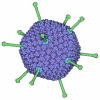[English] 日本語
 Yorodumi
Yorodumi- PDB-1gw8: quasi-atomic resolution model of bacteriophage PRD1 sus607 mutant... -
+ Open data
Open data
- Basic information
Basic information
| Entry | Database: PDB / ID: 1gw8 | ||||||
|---|---|---|---|---|---|---|---|
| Title | quasi-atomic resolution model of bacteriophage PRD1 sus607 mutant, obtained by combined cryo-EM and X-ray crystallography. | ||||||
 Components Components | MAJOR CAPSID PROTEIN | ||||||
 Keywords Keywords | VIRUS/VIRAL PROTEIN / TECTIVIRIDAE / BACTERIOPHAGE PRD1 / CRYO- EM / IMAGE RECONSTRUCTION / ICOSAHEDRAL VIRUS / VIRUS-VIRAL PROTEIN complex | ||||||
| Function / homology | Bacteriophage PRD1, P3 / Bacteriophage PRD1, P3, N-terminal / P3 major capsid protein N-terminal / Group II dsDNA virus coat/capsid protein / Viral coat protein subunit / viral capsid / Major capsid protein P3 Function and homology information Function and homology information | ||||||
| Biological species |   BACTERIOPHAGE PRD1 (virus) BACTERIOPHAGE PRD1 (virus) | ||||||
| Method | ELECTRON MICROSCOPY / single particle reconstruction / cryo EM / Resolution: 13.3 Å | ||||||
 Authors Authors | San Martin, C. / Huiskonen, J. / Bamford, J.K.H. / Butcher, S.J. / Fuller, S.D. / Bamford, D.H. / Burnett, R.M. | ||||||
 Citation Citation |  Journal: Nat Struct Biol / Year: 2002 Journal: Nat Struct Biol / Year: 2002Title: Minor proteins, mobile arms and membrane-capsid interactions in the bacteriophage PRD1 capsid. Authors: Carmen San Martín / Juha T Huiskonen / Jaana K H Bamford / Sarah J Butcher / Stephen D Fuller / Dennis H Bamford / Roger M Burnett /  Abstract: Bacteriophage PRD1 shares many structural and functional similarities with adenovirus. A major difference is the PRD1 internal membrane, which acts in concert with vertex proteins to translocate the ...Bacteriophage PRD1 shares many structural and functional similarities with adenovirus. A major difference is the PRD1 internal membrane, which acts in concert with vertex proteins to translocate the phage genome into the host. Multiresolution models of the PRD1 capsid, together with genetic analyses, provide fine details of the molecular interactions associated with particle stability and membrane dynamics. The N- and C-termini of the major coat protein (P3), which are required for capsid assembly, act as conformational switches bridging capsid to membrane and linking P3 trimers. Electrostatic P3-membrane interactions increase virion stability upon DNA packaging. Newly revealed proteins suggest how the metastable vertex works and how the capsid edges are stabilized. #1:  Journal: Acta Crystallogr D Biol Crystallogr / Year: 2002 Journal: Acta Crystallogr D Biol Crystallogr / Year: 2002Title: The X-ray crystal structure of P3, the major coat protein of the lipid-containing bacteriophage PRD1, at 1.65 A resolution. Authors: Stacy D Benson / Jaana K H Bamford / Dennis H Bamford / Roger M Burnett /  Abstract: P3 has been imaged with X-ray crystallography to reveal a trimeric molecule with strikingly similar characteristics to hexon, the major coat protein of adenovirus. The structure of native P3 has now ...P3 has been imaged with X-ray crystallography to reveal a trimeric molecule with strikingly similar characteristics to hexon, the major coat protein of adenovirus. The structure of native P3 has now been extended to 1.65 A resolution (R(work) = 19.0% and R(free) = 20.8%). The new high-resolution model shows that P3 forms crystals through hydrophobic patches solvated by 2-methyl-2,4-pentanediol molecules. It reveals details of how the molecule's high stability may be achieved through ordered solvent in addition to intra- and intersubunit interactions. Of particular importance is a 'puddle' at the top of the molecule containing a four-layer deep hydration shell that cross-links a complex structural feature formed by 'trimerization loops'. These loops also link subunits by extending over a neighbor to reach the third subunit in the trimer. As each subunit has two eight-stranded viral jelly rolls, the trimer has a pseudo-hexagonal shape to allow close packing in its 240 hexavalent capsid positions. Flexible regions in P3 facilitate these interactions within the capsid and with the underlying membrane. A selenometh-ionine P3 derivative, with which the structure was solved, has been refined to 2.2 A resolution (R(work) = 20.1% and R(free) = 22.8%). The derivatized molecule is essentially unchanged, although synchrotron radiation has the curious effect of causing it to rotate about its threefold axis. P3 is a second example of a trimeric 'double-barrel' protein that forms a stable building block with optimal shape for constructing a large icosahedral viral capsid. A major difference is that hexon has long variable loops that distinguish different adenovirus species. The short loops in P3 and the severe constraints of its various interactions explain why the PRD1 family has highly conserved coat proteins. #2:  Journal: Structure / Year: 2001 Journal: Structure / Year: 2001Title: Combined EM/X-ray imaging yields a quasi-atomic model of the adenovirus-related bacteriophage PRD1 and shows key capsid and membrane interactions. Authors: C S Martín / R M Burnett / F de Haas / R Heinkel / T Rutten / S D Fuller / S J Butcher / D H Bamford /  Abstract: BACKGROUND: The dsDNA bacteriophage PRD1 has a membrane inside its icosahedral capsid. While its large size (66 MDa) hinders the study of the complete virion at atomic resolution, a 1.65-A ...BACKGROUND: The dsDNA bacteriophage PRD1 has a membrane inside its icosahedral capsid. While its large size (66 MDa) hinders the study of the complete virion at atomic resolution, a 1.65-A crystallographic structure of its major coat protein, P3, is available. Cryo-electron microscopy (cryo-EM) and three-dimensional reconstruction have shown the capsid at 20-28 A resolution. Striking architectural similarities between PRD1 and the mammalian adenovirus indicate a common ancestor. RESULTS: The P3 atomic structure has been fitted into improved cryo-EM reconstructions for three types of PRD1 particles: the wild-type virion, a packaging mutant without DNA, and a P3-shell lacking ...RESULTS: The P3 atomic structure has been fitted into improved cryo-EM reconstructions for three types of PRD1 particles: the wild-type virion, a packaging mutant without DNA, and a P3-shell lacking the membrane and the vertices. Establishing the absolute EM scale was crucial for an accurate match. The resulting "quasi-atomic" models of the capsid define the residues involved in the major P3 interactions, within the quasi-equivalent interfaces and with the membrane, and show how these are altered upon DNA packaging. CONCLUSIONS: The new cryo-EM reconstructions reveal the structure of the PRD1 vertex and the concentric packing of DNA. The capsid is essentially unchanged upon DNA packaging, with alterations ...CONCLUSIONS: The new cryo-EM reconstructions reveal the structure of the PRD1 vertex and the concentric packing of DNA. The capsid is essentially unchanged upon DNA packaging, with alterations limited to those P3 residues involved in membrane contacts. These are restricted to a few of the N termini along the icosahedral edges in the empty particle; DNA packaging leads to a 4-fold increase in the number of contacts, including almost all copies of the N terminus and the loop between the two beta barrels. Analysis of the P3 residues in each quasi-equivalent interface suggests two sites for minor proteins in the capsid edges, analogous to those in adenovirus. #3:  Journal: Cell / Year: 1999 Journal: Cell / Year: 1999Title: Viral evolution revealed by bacteriophage PRD1 and human adenovirus coat protein structures. Authors: S D Benson / J K Bamford / D H Bamford / R M Burnett /  Abstract: The unusual bacteriophage PRD1 features a membrane beneath its icosahedral protein coat. The crystal structure of the major coat protein, P3, at 1.85 A resolution reveals a molecule with three ...The unusual bacteriophage PRD1 features a membrane beneath its icosahedral protein coat. The crystal structure of the major coat protein, P3, at 1.85 A resolution reveals a molecule with three interlocking subunits, each with two eight-stranded viral jelly rolls normal to the viral capsid, and putative membrane-interacting regions. Surprisingly, the P3 molecule closely resembles hexon, the equivalent protein in human adenovirus. Both viruses also have similar overall architecture, with identical capsid lattices and attachment proteins at their vertices. Although these two dsDNA viruses infect hosts from very different kingdoms, their striking similarities, from major coat protein through capsid architecture, strongly suggest their evolutionary relationship. | ||||||
| History |
| ||||||
| Remark 700 | SHEET THE SHEET STRUCTURE OF THIS MOLECULE IS BIFURCATED. IN ORDER TO REPRESENT THIS FEATURE IN ... SHEET THE SHEET STRUCTURE OF THIS MOLECULE IS BIFURCATED. IN ORDER TO REPRESENT THIS FEATURE IN THE SHEET RECORDS BELOW, TWO SHEETS ARE DEFINED. |
- Structure visualization
Structure visualization
| Movie |
 Movie viewer Movie viewer |
|---|---|
| Structure viewer | Molecule:  Molmil Molmil Jmol/JSmol Jmol/JSmol |
- Downloads & links
Downloads & links
- Download
Download
| PDBx/mmCIF format |  1gw8.cif.gz 1gw8.cif.gz | 749.4 KB | Display |  PDBx/mmCIF format PDBx/mmCIF format |
|---|---|---|---|---|
| PDB format |  pdb1gw8.ent.gz pdb1gw8.ent.gz | 584.3 KB | Display |  PDB format PDB format |
| PDBx/mmJSON format |  1gw8.json.gz 1gw8.json.gz | Tree view |  PDBx/mmJSON format PDBx/mmJSON format | |
| Others |  Other downloads Other downloads |
-Validation report
| Arichive directory |  https://data.pdbj.org/pub/pdb/validation_reports/gw/1gw8 https://data.pdbj.org/pub/pdb/validation_reports/gw/1gw8 ftp://data.pdbj.org/pub/pdb/validation_reports/gw/1gw8 ftp://data.pdbj.org/pub/pdb/validation_reports/gw/1gw8 | HTTPS FTP |
|---|
-Related structure data
| Related structure data |  1012MC  1011C  1gw7C C: citing same article ( M: map data used to model this data |
|---|---|
| Similar structure data |
- Links
Links
- Assembly
Assembly
| Deposited unit | 
|
|---|---|
| 1 | x 60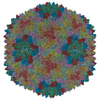
|
| 2 |
|
| 3 | x 5
|
| 4 | x 6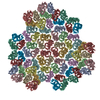
|
| 5 | 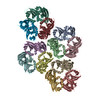
|
| Symmetry | Point symmetry: (Schoenflies symbol: I (icosahedral)) |
| Noncrystallographic symmetry (NCS) | NCS oper: (Code: given / Matrix: (1), |
- Components
Components
| #1: Protein | Mass: 43346.219 Da / Num. of mol.: 12 Source method: isolated from a genetically manipulated source Details: SUS607 MUTANT LACKS THE VIRAL MEMBRANE AGGREGATION PROTEIN P11 Source: (gene. exp.)   BACTERIOPHAGE PRD1 (virus) / Plasmid: PSN3 / Production host: BACTERIOPHAGE PRD1 (virus) / Plasmid: PSN3 / Production host:  SALMONELLA TYPHIMURIUM (bacteria) / Strain (production host): DS88 / References: UniProt: P22535 SALMONELLA TYPHIMURIUM (bacteria) / Strain (production host): DS88 / References: UniProt: P22535Compound details | BACTERIOPH | |
|---|
-Experimental details
-Experiment
| Experiment | Method: ELECTRON MICROSCOPY |
|---|---|
| EM experiment | Aggregation state: PARTICLE / 3D reconstruction method: single particle reconstruction |
- Sample preparation
Sample preparation
| Component | Name: BACTERIOPHAGE PRD1 SUS607 / Type: VIRUS |
|---|---|
| Buffer solution | Name: TRIS / pH: 7.2 / Details: TRIS |
| Specimen | Embedding applied: NO / Shadowing applied: NO / Staining applied: NO / Vitrification applied: YES |
| Specimen support | Details: HOLEY CARBON |
| Vitrification | Instrument: HOMEMADE PLUNGER / Cryogen name: ETHANE / Details: ETHANE |
| Crystal grow | *PLUS Method: cryo-electron microscopy |
- Electron microscopy imaging
Electron microscopy imaging
| Microscopy | Model: FEI/PHILIPS CM200FEG / Date: Dec 1, 2001 |
|---|---|
| Electron gun | Electron source:  FIELD EMISSION GUN / Accelerating voltage: 200 kV / Illumination mode: FLOOD BEAM FIELD EMISSION GUN / Accelerating voltage: 200 kV / Illumination mode: FLOOD BEAM |
| Electron lens | Mode: BRIGHT FIELD / Nominal magnification: 50000 X / Calibrated magnification: 45100 X / Nominal defocus max: 4100 nm / Nominal defocus min: 1300 nm / Cs: 2 mm |
| Specimen holder | Temperature: 95 K |
| Image recording | Electron dose: 6 e/Å2 / Film or detector model: KODAK SO-163 FILM |
| Image scans | Num. digital images: 21 |
| Radiation wavelength | Relative weight: 1 |
- Processing
Processing
| EM software |
| ||||||||||||||||
|---|---|---|---|---|---|---|---|---|---|---|---|---|---|---|---|---|---|
| CTF correction | Details: PHASE RESTORATION BY CTF- MULTIPLICATION OF IMAGES; AMPLITUDE RESTORATION BY COMPARISON WITH QUASI- ATOMIC MODEL | ||||||||||||||||
| Symmetry | Point symmetry: I (icosahedral) | ||||||||||||||||
| 3D reconstruction | Method: POLAR FOURIER TRANSFORM, CROSS- COMMON LINES / Resolution: 13.3 Å / Num. of particles: 1729 / Nominal pixel size: 3.68 Å / Actual pixel size: 3.32 Å / Magnification calibration: COMPARISON WITH X- RAY DATA Details: RIGID BODY REFINEMENT AGAINST CRYO-EM MAP XPLOR 3.851 (BRUNGER). DATA USED IN REFINEMENT. RESOLUTION RANGE HIGH INFINITY RESOLUTION RANGE LOW 15A DATA CUTOFF (SIGMA(F)) 0.0 NUMBER OF ...Details: RIGID BODY REFINEMENT AGAINST CRYO-EM MAP XPLOR 3.851 (BRUNGER). DATA USED IN REFINEMENT. RESOLUTION RANGE HIGH INFINITY RESOLUTION RANGE LOW 15A DATA CUTOFF (SIGMA(F)) 0.0 NUMBER OF REFLECTIONS 1430672 FIT TO DATA USED IN Symmetry type: POINT | ||||||||||||||||
| Atomic model building | Protocol: RIGID BODY FIT / Space: RECIPROCAL / Target criteria: R-factor / Details: METHOD--RIGID BODY REFINEMENT PROTOCOL--X-RAY | ||||||||||||||||
| Atomic model building | PDB-ID: 1HX6 Accession code: 1HX6 / Source name: PDB / Type: experimental model | ||||||||||||||||
| Refinement | Highest resolution: 13.3 Å | ||||||||||||||||
| Refinement step | Cycle: LAST / Highest resolution: 13.3 Å
|
 Movie
Movie Controller
Controller







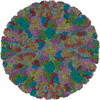

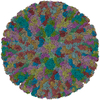
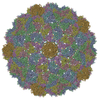
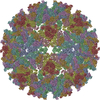




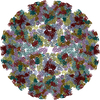
 PDBj
PDBj